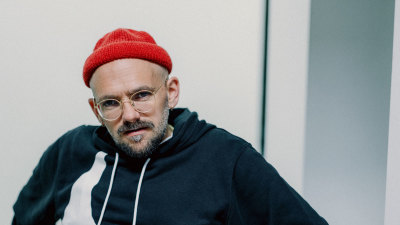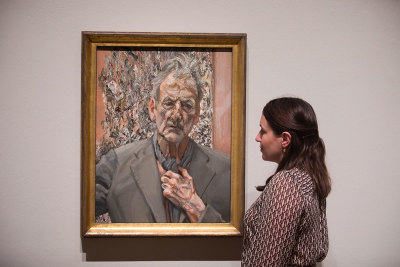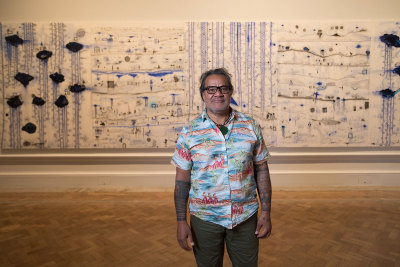My studio life: Anthony Whishaw RA
My studio life: Anthony Whishaw RA
By Harriet Baker
Published 25 August 2015
From his studio in south west London, Anthony Whishaw RA tells us how he has been influenced by Goya, and why he enjoys working from two studios.
-
Anthony Whishaw RA was brought up in South America until he was nine years old, when he came to England to go to school. By 1952, after he had studied at the Chelsea School of Art, he was awarded a Spanish Government Scholarship to study art.
He lives and works in a studio in Kensington, south west London. The space, originally built as a studio in which to draw horses, housed his family and, more recently, has become his primary studio. He also works from a second studio in Bethnal Green, to which paintings are sent when they are “misbehaving themselves”.
We visited the artist in his studio, where he revealed his working practice, from his battle between abstraction and figuration, to why he prefers to use acrylic paints. Portraits by Eamonn McCabe.
-

This used to be a studio for animals
The studio was built in the late 1890s when cars didn’t exist but horses did. They were studied here. In later years the space was used for pottery, sculpture and painting.
High up on the wall is my painting Corrida, which means ‘running’. It was painted in Madrid during my scholarship there in 1955 and was much inspired by Goya. I have been influenced by Francis Bacon, too, which you can see in the figure of the screaming child
© Eamonn McCabe
-

I saw Goya's 'Black Paintings' and was knocked out
I was brought up in Brazil until I was nine years old when I came to England with my mother, just before World War II, to go to school for the first time. Perhaps as a result of being in South America I was unconsciously intrigued to visit Spain, which I did in 1951, and then in 1954 when I first first saw Goya’s paintings in the Prado Museum. They blew my mind. By 1955 I had a Spanish Government scholarship to study art
© Eamonn McCabe
-

I have a siesta habit
I’ve lived in Kensington since 1957 – the whole house is my studio. The houses around here are all being redeveloped, with basement swimming pools and sunken garages. They’ve put railings up and shrubs outside my door, so it’s difficult to get my paintings through. A lot of them are about 15 feet long.
Because of my love of Spain, I have a siesta habit, but with the sound of all the excavating next door, it’s impossible
© Eamonn McCabe
-

On having two studios
I also have another studio in Bethnal Green and have been working there since 1981. In the last few years I’ve been working in both places, driving to Bethnal Green in the early morning. I work there from 6am until midday and then I drive back, eat my lunch and have my siesta. So, I have 2 days in one!
© Andrew McCargow / Acme
-

On being an artist
As a painter I want to surprise myself and discover unexpected images. I explore different visual languages, influenced by late Goya, Velazquez, Zurbaran and Cubism. This can be seen in my larger paintings – completed in my Bethnal Green studio – where the variety of scale and subject can be seen
© Eamonn McCabe
-

The lovely thing about acrylic paint
I gave up using oil paint at the end of the 1960s and moved to acrylic. Because of the scale and number of paintings I work on, water-based acrylic dries so much quicker than oil paint. It means I can work on large areas of canvas on the floor, the paint can soak into the canvas, and depending on the temperature it will dry overnight, which is not possible with oil paint
© Eamonn McCabe
-

Cement, ash, plaster, wood, paper and soil
I use Tetrion which is a kind of plaster mixed with acrylic, making a much thicker form of paint to use on canvas or board. I have occasionally used cement, ash, wood and paper – all sorts of things.
I have to heat the soil enough to prevent plant growth and destroy any possibility of insects taking control of the work, though sometimes this changes the colour. Using Tetrion helps to remove the shiny plastic surface that acrylic can produce
© Andrew McCargow / Acme
-

Some influences
I am visually indebted to several painters and works, especially to Goya’s etchings and his Black paintings, Velazquez’s Las Meninas, to Picasso and Braque, and to Cubism. I feel highly involved with the battle between figuration and abstraction, relying on a certain amount of visual play with illusion/allusion, usually triggered by the work itself
© Andrew McCargow / Acme
-

Scale and subject
I work in a variety of sizes and subjects. The largest painting in my Bethnal Green studio is called The Blind Leading the Blind (pictured, right) which is related to Brueghel, but also to Goya, Picasso and Zurbaran. Smaller works are related to the landscapes of South America – with its Pueblos and its horizon lines – and to cubism
© Andrew McCargow / Acme
-

Playing with space
This small work – depicting a view through a window – has two interpretations. It takes the brain some time to realise. The first is a plant in front of the window, and then you see a woman leaning forward and looking out
© Eamonn McCabe
-

Come dance with me
This painting is called Come Dance With Me, and it was in the Summer Exhibition 2015. It quite unexpectedly developed from a faint echo from half a century ago. In the mid-1960’s I worked on many paintings with a dance theme, which was linked to a gradual disintegration of realism and depiction of human activity, which coincided with my move from oil to acrylic paints
© Eamonn McCabe
-

On paintings misbehaving themselves
I sometimes take small paintings from my home studio to my Bethnal Green studio and vice versa. I do this when they have got stuck and are not developing. It’s good for them to be confronted with other paintings, with different visual ideas. Sometimes this works – they turn into maverick images or even suggest a hybrid group, but sometimes they get destroyed
© Eamonn McCabe















